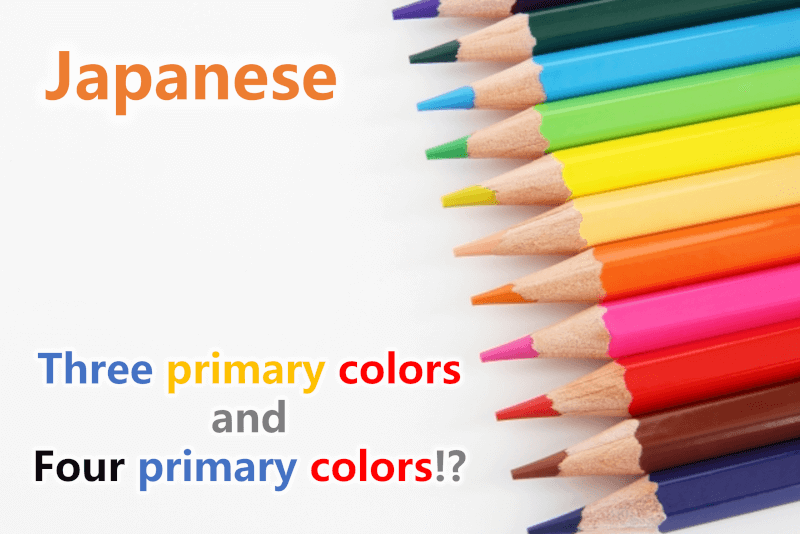Click here for the Chinese version
点击这里并查看中文版本
Names of the colors are mysterious
Each language has basic color names. These basic color names have similarities, but there are also differences.
These differences came from the geographical locations and the cultural backgrounds.
In 1969, Brent Berlin and Paul Kay published an interesting paper called "Basic Color Terms". They examined 98 languages around the world, studied the semantic comparison of color words, and found the similarities and the differences.
Regarding Japanese, ancient Japanese people used their original Japanese speaking to call the colors, and after Chinese characters arrived in Japan, they assigned Chinese characters to the colors considering the meaning of Chinese characters.
However, due to the cultural backgrounds, the color names in Japanese and Chinese not coincidence. It is not same as English either. You may be confused by the differences.
Let us take a look at the basic color terms in Japanese!
気になる内容にすぐに移動
Three primary colors and three secondary colors

Three primary colors - red, yellow and blue
Three primary colors (in paint) are red, yellow and blue which are same as English, and the Japanese names are as follows.
- Red = 赤 [あか] [aka]
- Yellow = 黄 [き] [ki]
- Blue = 青 [あお] [ao]
You may know that "紅" [べに] [beni] in Japanese is one of red color range and often refers to deeper and fresher red.
Sometimes, "紅" and "白" [しろ] [shiro] are used together and represent celebration.
In Chinese language, "紅" is called [hóng] and it is the red of three primary colors.
"青" refers to blue in Japanese. However, it is little tricky. We will get deeper into this later.
In Chinese language, "蓝" is called [lán] and it is the blue of three primary colors.
"藍" is the equivalent Japanese Kanji. In Japanese, it refers to indigo blue, which is a deeper blue color.
- 紅 [べに] [beni]
- 藍 [あい] [ai]
Green, orange and violet (purple) are three secondary colors, which are same as English.
- Green = 緑 [みどり] [midori]
- Orange = 橙 [だいだい] [daidai]
- Violet (Purple) = 紫 [むらさき] [murasaki]
However, green is also tricky in Japanese language.
Color adjectives in Japanese
We can express some colors adding "い" [i] adjectivally, for example:
- White snow: 白い雪 [しろい ゆき] [shiroi yuki]
- Black cat: 黒い猫 [くろい ねこ] [kuroi neko]
- Red clothes: 赤い服 [あかい ふく] [akai fuku]
- Blue ocean: 青い海 [あおい うみ] [aoi umi]
However, "い" [i] cannot be added to others, meaning only white, black, red, and blue can be the adjectives.
Although we can say:
- 黄色い [きいろい] [kiiroi]
But we cannot say "黄い" [きい] [kii].
This is because only white, black, red, and blue were expressions of ancient Japan, and these four colors can be added with "い" [i] to use as the adjectives.
How come it happened?
White, blue, red, and black in Japanese
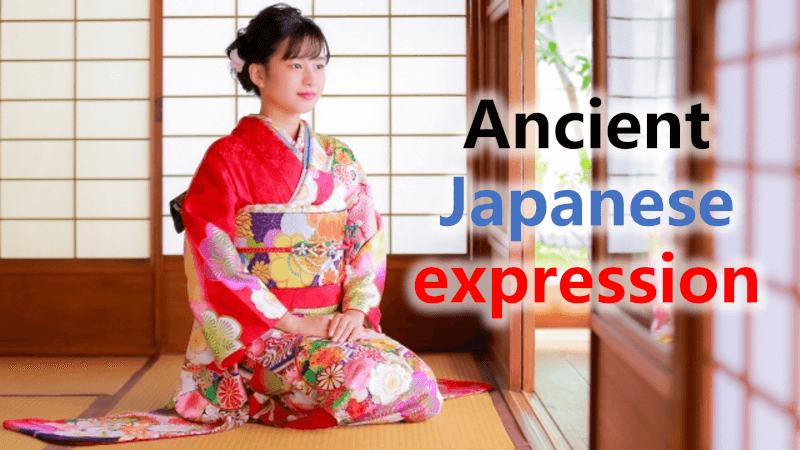
According to common theory, ancient Japan only used the following four expressions, which are different from today's Japanese color expressions.
- Ancient → Today
- しろ [shiro] → 白 [しろ] = White
- あお [ao] → 青 [あお] = Blue
- あか [aka] → 赤 [あか] = Red
- くろ [kuro] → 黒 [くろ] = Black
Ancient Japanese expressions
Dr. Akira Asano (浅野晃 - Imaging Science & Photographic Technology, Kansai University) explains the following 4 expressions.
- しろ [shiro]: The original Kanji was "顕", representing clarity and high saturation.
- あお [ao]: The original Kanji was "漠", representing vague and low saturation.
- あか [aka]: The original Kanji was "明", representing bright (high brightness).
- くろ [kuro]: The original Kanji was "暗", representing dark (low brightness).
The meaning of あお [ao] is "blurry color", which means various tones other than white, red, and black.
In this era, there were no correct names for colors, such as "green", "yellow", etc.
This shows that none of the four definitions above are color names, but rather for visual influence.
This is the reason why only white, blue, red, and black can be added with "い" [i] to use as the adjectives.
Blue and green in Japanese
You may say "Blue and green are different colors and cannot be mixed up".
However, sometimes Japanese people use the word of "blue" for "green".
How come it happened?
We already understood that the name of "blue" in Japanese is "青", and the original Japanese word "青" was a visual expression, but now it has become a color name.
It gives us the answer.
Let us take a look at a few examples.
Apple
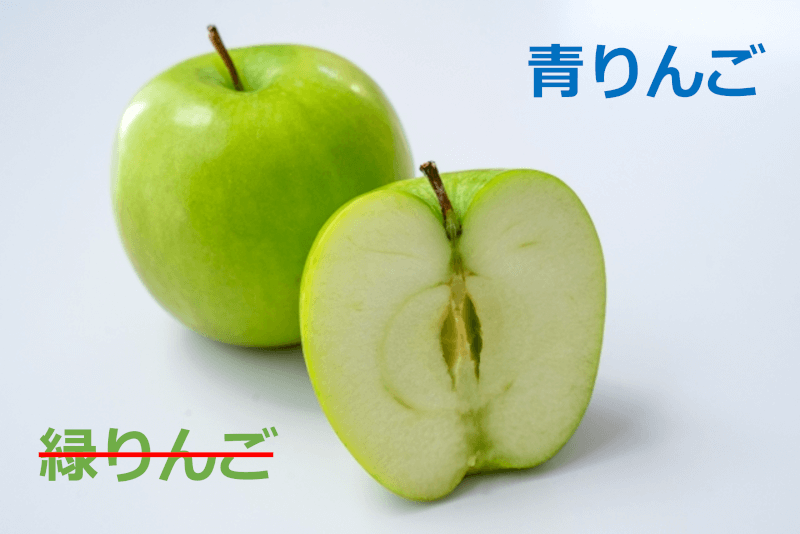
Common apple colors are red, yellow and green, and each apple is called with its color.
The Japanese call "blue apple" instead of "green apple". "Green apple" is incorrect.
In Chinese, it is also known as "blue apple", it is same aspect.
Green apple
= 青林檎 [あお りんご] [ao ringo] (in Japanese)
= 青苹果 [qīng píng guǒ] (in Chinese)
Bamboo
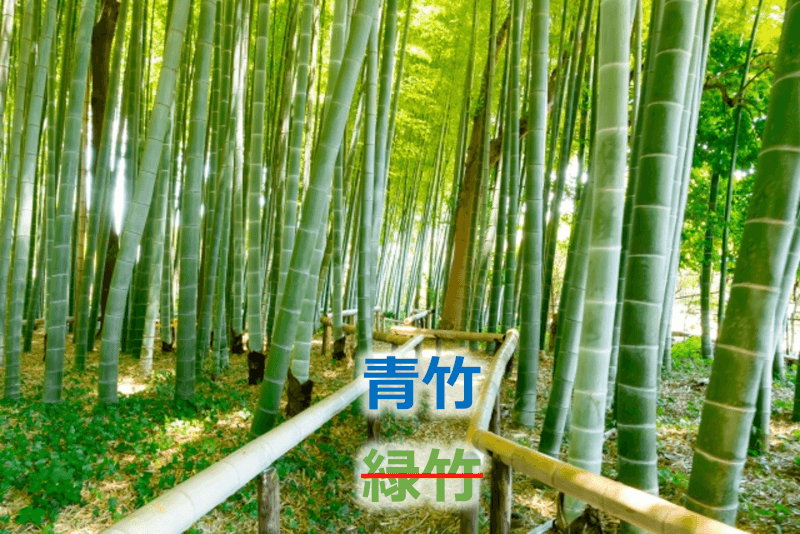
Although the color of bamboo is green, Japanese call it "青竹" (blue bamboo).
Green bamboo = 青竹 [あおたけ] [aotake]
Grassland

"Green grassland" in Japanese is
青々とした草原 [あおあおとした そうげん] [ao ao toshita sogen]
In Chinese, both expressions are correct.
绿绿的草原 [lǜ lǜ de cǎo yuán]
青青的草原 [qīng qīng de cǎo yuán]
Young person
In Japanese and Chinese, young person is called "少年".
As the Kanji shows, it means "less aged".
Also called as "青少年" or "青年".
Young person = 青少年
Japanese: [せいしょうねん] [sei shou nen]
Chinese: [qīng shǎo nián]
Young person = 青年
Japanese: [せいねん] [sei nen]
Chinese: [qīng nián]
In addition to this, "青春" represents "youth", which is "blue" + "spring".
Youth = 青春
Japanese: [せいしゅん] [sei shun]
Chinese: [qīng chūn]
From the above example, we understand that "青" represents "not yet mature" or "fresh".
※ Although "green apple" is one of the apple varieties
Season
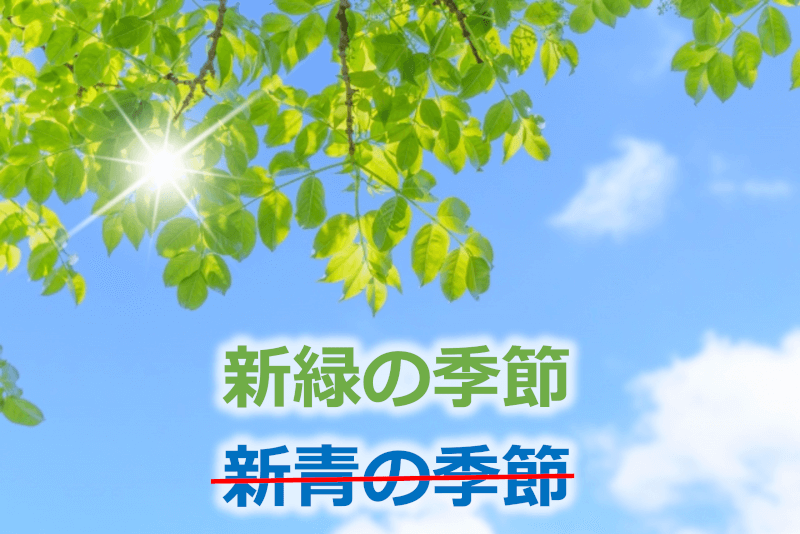
Here is the exception.
In Japanese, we can say "the season of new green" but cannot say "the season of new blue".
新緑の季節 [しんりょく の きせつ] [shinryoku no kisetsu]
Another example of "green" is...
Traffic lights
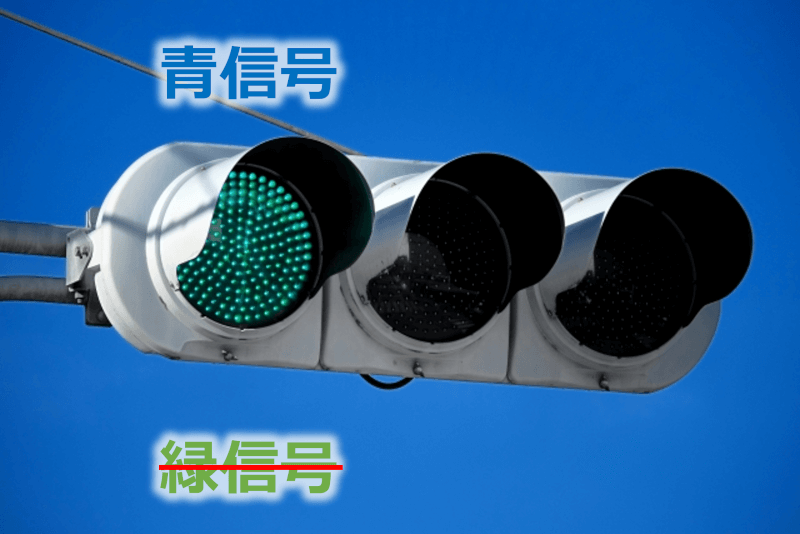
As we all know, the three colors of traffic lights are green, yellow and red.
The colors of traffic lights in Japan are also similar.
However, Japanese call "blue light" instead of "green light".
Green light = 青信号 [あお しんごう] [ao shingou]
Of course, traffic lights are not fresh stuff. However, Japanese people still use the expression of "blue".
It is unique expression in Japanese, not applicable to Chinese.
Although you know that every language has exceptions, are you feeling the usage of "青" is unclear?
Please remember the origin of "青".
あお [ao]: The original Kanji was "漠", representing vague and low saturation.
Yes, you are right! "青" is "blurry color"!
In Chinese, "青" may refer to black in addition to green, but Japanese does not refer to black.
Finally, let me show you an example of "red".
Lie

In Japanese, we can say "bright red lies".
真っ赤な嘘 [まっかな うそ] [makkana uso]
This means "a lie which can be clearly found", and by reading the previous explanation, we have already understood the meaning of "赤"!
あか [aka]: The original Kanji was "明", representing bright (high brightness).
I spent hours in researching and writing this blog article. I am hoping that you now have a clear understanding of the basic color expression in Japanese.
In Japanese, "明白" means "clear", it is similar to Chinese.
Clear = 明白
Japanese: [めいはく] [meihaku]
Chinese: [míng bái]
しろ [shiro]: The original Kanji was "顕", representing clarity and high saturation.
Every country and place have a variety of color names.
Learning a foreign language not only learning language, but also learning cultural backgrounds.
I hope you feel it is interesting!
Thank you for reading!




